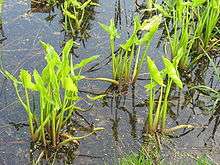Peltandra virginica
| tuckahoe green arrow arum | |
|---|---|
 | |
| Scientific classification | |
| Kingdom: | Plantae |
| (unranked): | Angiosperms |
| (unranked): | Monocots |
| Order: | Alismatales |
| Family: | Araceae |
| Subfamily: | Aroideae |
| Genus: | Peltandra |
| Species: | P. virginica |
| Binomial name | |
| Peltandra virginica (L.) Schott | |
| Synonyms[1] | |
| |
Peltandra virginica is a plant of the Araceae family known by the common names green arrow arum and tuckahoe. It is widely distributed in wetlands in the eastern United States, as well as in Quebec, Ontario, and Cuba.[1][2][3] It is common in central Florida including the Everglades[4] and along the Gulf Coast.[5] Its rhizomes are tolerant to low oxygen levels found in wetland soils.[6] It can be found elsewhere in North America as an introduced species and often an invasive plant.
This is an emergent perennial herb growing from a large rhizome and producing many large leaves. An individual leaf may have a petiole nearly a meter long and a blade half a meter in length. The leaves are quite variable in shape and size, but they are often generally arrowhead-shaped.
The inflorescence bears male and female flowers, as well as sterile flowers. The flower varies from whitish to greenish to yellow. The fruit is a brown berry containing a few seeds within a clear gelatinous pulp. Large number of seeds can accumulate in the soil of wetlands.[2][7]
The fly Elachiptera formosa breeds in this plant, mating on the inflorescence and laying eggs there, so the larvae can feed on the rotting spadix.[8]
The plant contains calcium oxalate crystals, making it unpalatable. Native Americans used most parts of the plant for food, however, cooking it for hours first to make it safe to eat.[8][9]
References
- 1 2 Kew World Checklist of Selected Plant Families
- 1 2 Whigham, Dennis F., Robert L. Simpson and Mary A. Leck. 1979. The Distribution of Seeds, Seedlings, and Established Plants of Arrow Arum (Peltandra virginica (L.) Kunth) in a Freshwater Tidal Wetland Bulletin of the Torrey Botanical Club 106: 193-199
- ↑ Acevedo-Rodríguez, P. & Strong, M.T. (2012). Catalogue of seed plants of the West Indies. Smithsonian Contributions to Botany 98: 1-1192.
- ↑ Loveless, C. M. 1959. A study of the vegetation in the Florida everglades. Ecology 40: 1–9.
- ↑ Keddy, P. A., Campbell, D., McFalls T., Shaffer, G., Moreau, R., Dranguet, C., and Heleniak, R. (2007). The wetlands of lakes Pontchartrain and Maurepas: past, present and future. Environmental Reviews 15: 1–35.
- ↑ Laing, H. E. (1940). Respiration of the rhizomes of Nuphar advenum and other water plants. American Journal of Botany 27: 574–81.
- ↑ Leck, M. A. and Graveline, K. J. (1979). The seed bank of a freshwater tidal marsh. American Journal of Botany 66: 1006–15.
- 1 2 Flora of North America
- ↑ Plant of the Week
External links
- Jepson Manual Treatment
- USDA Plants Profile
- GRIN Species Profile
- Information from the Center for Aquatic and Invasive Plants of the University of Florida.